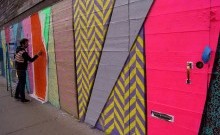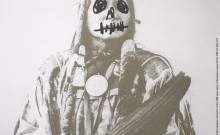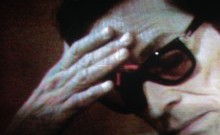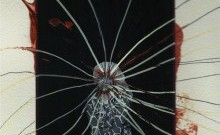The Films of Manuel Alejandro Salas

Ecuadorean born, NYC based filmmaker Manuel Alejandro Salas is on his way to true auteur-ship as a director, a disciplined practice which not only includes directing but performing, writing, editing, composition and the many other details Salas handcrafts. At only 23 years old, he has created a slate of films even Tarkovsy himself would be proud of.
Forty years from now when we study film history, it won’t be Salas’ films that represent American filmmaking in 2015. Salas’ films are too pure. They’re too intellectual. They have poetry. His films are not a representation of filmmaking today. Because filmmaking today isn’t cinema.
“Si alguien intenta llegar a ser director de cine, está arriesgando su vida entera,
y él es el único responsable de ese riesgo” – Andrei Tarkovsy, Sculpting in Time

KP: What does the writing say?
MA: I use my poems in the paintings - which are the poems I use in my films. The way I write my films is with Shakespearean language. It feels more natural to write poetry that way.
“Poetry is an awareness of the world, a particular way of relating to reality.” – A.T.
KP: Like in your film Pisa? The monologue in Pisa is really striking, and that's you playing the character. Is that your actual voice or is it dubbed? It sounds like a possessed 16th century English town crier. What was your inspiration for this character?
MA: The performance is inspired by the character Alex from A Clockwork Orange. It’s a film I’m close to because it’s the one that got me interested in cinema. When I was young I thought cinema was just expensive blockbuster movies, because those are the films I was exposed to. But Clockwork Orange completely changed my mind and made me see cinema as an art form.
MA: I’m really big into studying cinema and it definitely influences my work. I have an Instagram account called @cahiersducinema, inspired by the French magazine, where I write reviews of films. I study a lot of different movements and filmmakers, not only their filmography but their life. I think it’s just as important to study a filmmaker’s life and learn how they achieved what they did. I got into surrealism, Alejandro Jodorowsky and then European cinema, Bergman, Tarkovsky, Pasolini, Fellini, and then Asian cinema with Kurosawa and Takashi Miike. And Wong Kar-Wai, a filmmaker from Hong Kong, big fan of his.
Right now I’m young, so I’m just learning. I’m making short films so I can develop my own voice by experimenting with different influences.
“Some sort of pressure must exist; the artist exists because the world is not perfect.
Art would be useless if the world were perfect, as man wouldn’t look for harmony but would simply live in it.
Art is born out of an ill-designed world.” – A.T.
KP: Based on your slate of films it looks like you’ve been making a film every year for the past several years - and you’re only 23. Is it your goal to make one film per year?
MA: Yeah, it started in 2009. I know I have to keep practicing so I made that goal. Sometimes I make more than one, but the goal is at least one per year to keep growing and finding my own voice, until I’m ready to make my first feature. I’ve set a goal that it has to be around 10 years before I fully develop my style and voice and be at the point where I can make my first feature.
KP: Your discipline is impressive, especially since you shoot on 16mm. Would the feature be as expressionistic as the shorts, or would it be more narrative?
MA: I want my features to be more narrative and have more of a storyline. My work now is very abstract, but I do want a good balance. Bergman was someone who had the perfect balance of abstract, romantic, expressionism, but it had a storyline.
“A book read by a thousand different people is a thousand different books.”– A.T
KP: Tarkovsky is another big influence for you, hence your short films Amor Con Hambre and Zapotal.
MA: Yes Andrei Tarkovsky is an obsession. Amor con Hambre and Zapotal are an ode to Tarkovsky because at that time I was just watching every single film of his.
KP: I thought those films were great, as a concept really simple but sophisticated in the sense that a lot of young filmmakers try to complicate things. It’s refreshing because there’s a confidence in the way you place things, you’re not afraid of minimalism. Tarkovsky is someone who brings those two worlds together - the narrative human element along with design and composition.
MA: I’m inspired by Tarkovsky's impressive filmography. There are two types of filmmakers, the ones that make just 7-10 great films and then the ones who make over 40, 50 films and only 10 are good and the rest are just ok. For me, the filmmakers that have a small amount of films are really interesting. Like Kubrick and Tarkovsky, they choose their work really well and every single film is a masterpiece.
KP: This type of filmmaker is maybe more devoted to a craftsman type process, by constantly creating they occasionally stumble upon moments of greatness. Whereas, Kubrick or Tarkovsky would take a more monastic, student approach, spending a long time in development, reading and researching.
Are you a fan of Pablo Larraín’s films? He’s from Chile. There’s a lot of cool stuff coming out of Chile.
MA: Yeah, he did Tony Manero, Post Mortem. And then after those films he got called by HBO to do the Latin American show, Prófugos. Chile has a big film industry overall, they have a lot of good resources. I like Latin American cinema. I believe a country, or a continent, has a style that comes from it’s culture and sometimes what resonates in Latin American cinema is the poverty, like in Brazilian cinema, you see a lot of favelas. I’m not necessarily from one specific country, I left Ecuador when I was 7 and then lived in Costa Rica, Brazil, Chile, but I am Latin American, and in the future I want to represent Latin America as a filmmaker. I want to show a different side of our culture, not just poverty, crime and drugs.
KP: I’m curious about some of your visual techniques, such as the visual effect in Intoxicating Color. How did you create that composite and what does it represent?
MA: That’s actually honey, that I manipulated with water and light. It’s not a composite, it’s one image that dissolves to another. I’m not a huge fan of visual effects, so I was just playing around to see if I could make something without that source. It represents technology’s defeat over nature, a world in its premature state with only lava as its feeding organism. At the end of the short film, you can hear nature screaming, eager to be reborn and continue the cycle once again until technology wins over one more time.
MA: The negative side effect of technology is the price nature has to pay for our ambitious actions. We try to improve our tools to facilitate our way of living, but this is not done in harmony with the earth nor the neighbors we share this planet with. The biggest mistake any civilization can make is to lose the natural connection any living organism has with the energies in the cosmos. This partition can lead to self-destruction and make what was once part of creation become artificial.
“Modern mass culture, aimed at the 'consumer', the civilisation of prosthetics,
is crippling people's souls, setting up barriers between man and the crucial questions of his existence,
his consciousness of himself as a spiritual being.” - Andrei Tarkovsy, Sculpting in Time
KP: Another interesting quality in your films is the emphasis on sound design and music, which again seems to embrace the fundamentals of cinema. What is your approach to sound?
MA: For me, sound is just as important, if not more important, than the image. You can have something shot beautifully, but if the sound is not quality it diminishes the overall film. If I don’t have the means to record something well, I will use sounds from a music library. Most of the time I make my own music. I will sometimes go to churches in Costa Rica or Savannah or Chile and I’ll go to the choirs there and record them. Before making films, I was making music. I had a solo band called Aztec Oracles and I used to record a lot of music when I was in high school, I would play the piano, the guitar, the drums and do some vocals.
KP: It’s pretty awesome and unexpected to see that a lot of your work is shot on film, given most students only learn digital these days. Not too long ago you used to leave film school and know how to load a mag. Now people don’t know what that is, you just pop the card in. Did you start shooting on film at SCAD?
MA: I started before, when I was 17. I would go to film production companies in Chile to try to get the least expensive film equipment, but they wouldn’t let me rent it out because I wasn’t a qualified camera operator. So they called in this established Assistant Camera to help me, and at first he was a little weirded out by the obligation, like “who is this kid.” But we ended up working really well together. He liked what I was doing, he was passionate about it. And that’s the most important thing, to be with people who are passionate about the work. After that, we did three different films together.

KP: The DP is such an important partner for a director - it’s funny to find this person by coincidence. But it happens! A lot of creative work can be attributed to coincidences. Vanity Fair recently published an article on Orson Welles’ infamous unfinished film, The Other Side of the Wind. Gary Graver, an unknown cinematographer who worked in the naval film unit during Vietnam, basically cold called Orson Welles at the Beverly Hills hotel, surprisingly got through to him and expressed his interest in working with him. Long story short, Welles hired Gary that day, sight unseen, as the cinematographer for his final film. He became his right hand man. Orson found Gregg Toland the same way in the beginning of his career, and Gregg ended up as his cinematographer on Citizen Kane and they did many films together.
Will you go back to Chile to work with your DP on your next film?
MA: I would go back to Chile. For him and for me - there’s an energy there and I feel comfortable working there.
KP: It makes sense, it’s an important relationship. You establish a short-hand, a coded language after working together several times. It’s familiar, it’s like family kind of.
MA: The way I see it is that we don’t have to talk to each other to get exactly what we want. A lot of times we come up with things off-script on the set and they are nice surprises that just work. Like with Pisa, the part with the square, it was an object we just found last minute. And we were able to stage and light it well. Sometimes things out of the blue end up working really well.
Portrait of Manuel Alejandro Salas by Daniele Sarti | @danielesarti









